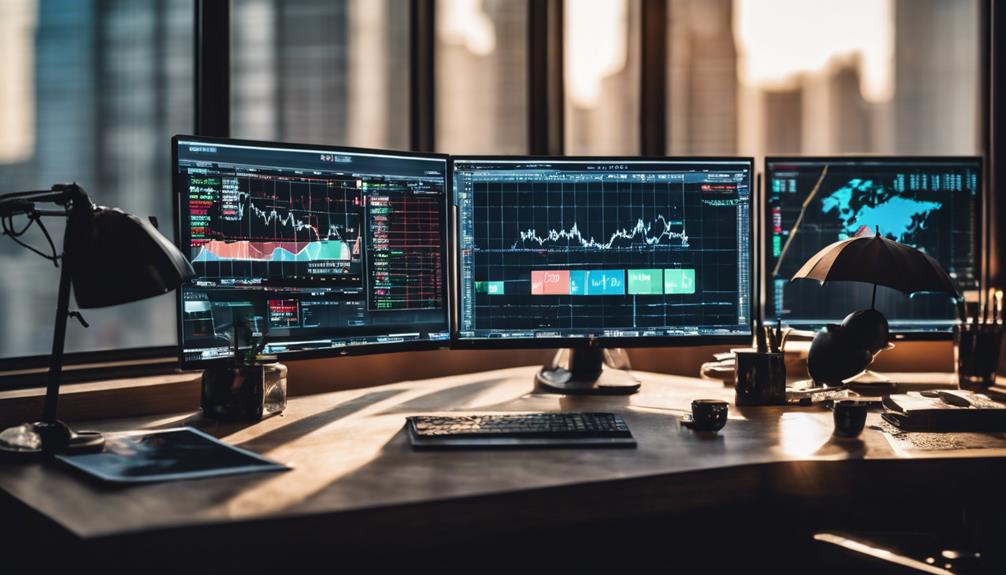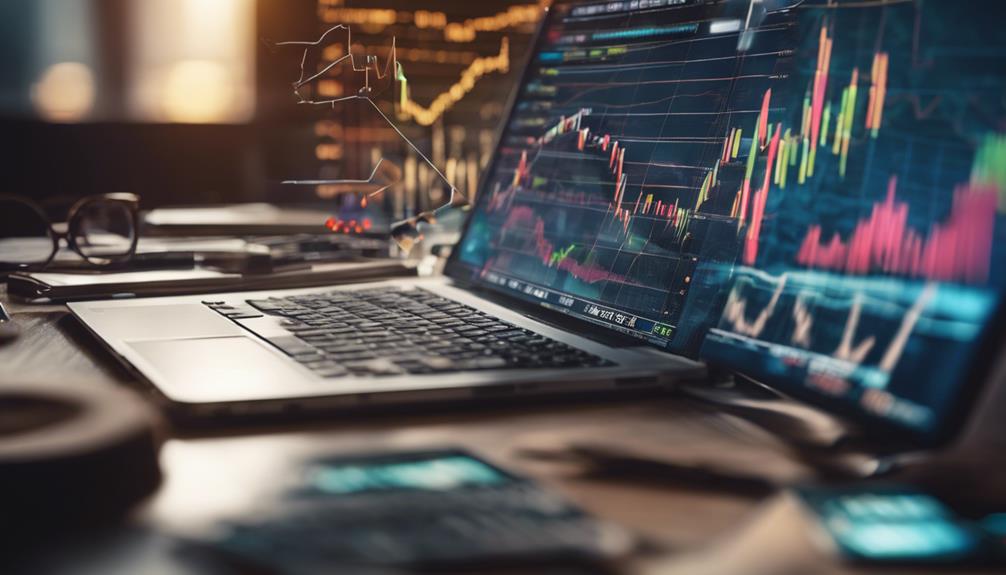Nearly 90% of forex traders leverage trading tools to enhance their market success, yet a significant portion still struggles to achieve consistent gains. You're likely aware that leveraging tools such as advanced charting software, real-time data analysis, and automated systems can drastically improve decision-making and risk management.
However, the key lies not just in the tools you use, but in how you apply them to your trading strategy. Balancing the power of these tools with a deep understanding of market dynamics is crucial. Let's explore how integrating these tools effectively can transform your trading approach, leaving behind the trial-and-error method for a more strategic pathway to forex success.
Key Takeaways
- Utilize advanced charting techniques and real-time data for precise entry and exit strategies.
- Implement automated trading systems to ensure consistency and eliminate emotional trading decisions.
- Apply rigorous risk management strategies, including stop-loss orders and diversification, to protect investments.
- Mastery of trading platforms and tools enhances efficiency and adaptability to market conditions.
Identifying Essential Tools

To achieve forex success, you'll need to master several essential tools, including charting platforms, economic calendars, news feeds, and technical analysis indicators. These resources are pivotal in developing a nuanced understanding of the market's dynamics, enabling you to leverage your trading strategies effectively. Charting platforms, such as MetaTrader, equip you with advanced tools for dissecting price movements and discerning trends, crucial for making informed decisions.
Economic calendars and news feeds are indispensable for staying ahead of market-moving events and economic updates that can significantly impact currency prices. By integrating this information into your analysis, you can better anticipate market shifts and adjust your positions accordingly, mitigating risk and optimizing the use of margin in your account.
Technical analysis indicators, including moving averages, RSI, and MACD, provide quantitative insights into market sentiment and price patterns. These tools help you refine your entry and exit points, maximizing capital efficiency. However, it's essential to remember that leverage amplifies both gains and losses. Therefore, successful traders not only understand how to utilize these tools but also how to manage the inherent risk associated with leveraged positions in the volatile forex market.
Advanced Charting Techniques
Delving deeper into the realm of forex trading, advanced charting techniques serve as a critical compass for navigating the volatile market landscape. These methods, including candlestick patterns and Fibonacci retracement, are not just tools but your allies in deciphering market movements and making calculated decisions. The power of leverage in forex trading amplifies the need for precision, where charting techniques and risk management strategies become paramount.
| Technique | Purpose | Importance in Leverage |
|---|---|---|
| Candlestick Patterns | Identify reversal points | High |
| Fibonacci Retracement | Predict support and resistance levels | Critical |
| Trendlines | Determine trend direction and breakout points | Essential |
Technical indicators like RSI and MACD, alongside chart patterns such as head and shoulders, provide insights into potential entry and exit points. This analytical prowess, combined with an understanding of margin requirements and margin calls, equips you to utilize the power of leverage effectively while mitigating risks. Mastery over these charting techniques empowers you to harness trading tools efficiently, making every decision, from trend analysis to risk management, informed and strategic. Remember, in the volatile forex market, your success hinges not just on the tools you use, but on how well you wield them.
Real-Time Data Analysis

Building on the foundation of advanced charting techniques, real-time data analysis becomes your next critical tool in forex trading, enabling you to act swiftly on market movements. This approach not only sharpens your ability to identify market trends but also underpins your strategies for leveraging profits and minimizing losses. By integrating real-time data analysis into your trading practice, you position yourself to respond with agility to the ever-changing forex market.
Here's how real-time data analysis elevates your trading game:
- Immediate Access to Market Trends: Stay ahead by monitoring price movements and economic indicators as they unfold.
- Precision in Entry and Exit Points: Make informed decisions on when to enter or exit a trade, optimizing your risk management.
- Enhanced Trade Strategies: Use up-to-the-minute information to refine your trade strategies, increasing your chances of success.
- Efficient Use of Trading Platforms: Leverage the features of trading platforms for quick reactions to market changes.
- Adaptability to Market Conditions: Real-time data analysis is essential for adapting strategies to dynamic market conditions, ultimately maximizing your profitability.
In essence, real-time data analysis is your linchpin for informed decision-making, allowing you to navigate the forex market with confidence and precision.
Automated Trading Systems
As you explore the realm of forex trading, understanding the role of automated trading systems becomes crucial for enhancing your strategy and efficiency. Automated trading systems, utilizing sophisticated algorithms, execute trades based on predefined criteria without the need for your direct intervention. This means they're constantly analyzing market data, making informed decisions, and placing trades to capitalize on market movements, all while you're focusing on other aspects of your trading plan or even while you're asleep.
These systems not only help in eliminating emotional trading decisions but also ensure consistency in your trading approach. Through backtesting, you can evaluate the effectiveness of your strategy against historical data, optimizing performance and adapting to changing market conditions without risking your capital. This level of efficiency and the ability to reduce manual errors significantly enhances your trading operations.
Moreover, automated trading systems offer the advantage of 24/7 trading capabilities, ensuring you don't miss out on any opportunities, even when the markets are volatile. Embracing these tools means you're not just trading smarter, but you're also leveraging technology to maintain a competitive edge in the fast-paced forex market.
Risk Management Strategies

To effectively manage risk in forex trading, it's crucial to implement strategies such as stop-loss orders and calculate position sizes based on your risk tolerance. Mastery in forex demands a deep understanding of leverage and its impact on risk management. By adjusting your position sizes, you navigate through market volatility with greater control, ensuring your trading capital isn't eroded during downturns.
Consider these pivotal strategies:
- Utilizing stop-loss orders to cap potential losses, safeguarding your investment against unforeseen market movements.
- Calculating position sizes with precision, tailored to your individual risk appetite, enhances your ability to withstand market fluctuations.
- Improving margin efficiency by vigilantly monitoring available capital, thus preventing margin calls that could liquidate your positions unexpectedly.
- Adopting diversification across various currency pairs to spread risk, potentially mitigating losses if one trade doesn't perform as expected.
- Continuously monitoring trades and adjusting risk-reward ratios to align with evolving market conditions and your trading objectives.
These strategies are the backbone of sound risk management in forex trading. By integrating them, you're not just protecting your capital; you're setting the stage for sustained success, leveraging tools that shield against volatility while optimizing returns.
Enhancing Decision Making
Mastering risk management strategies forms a solid foundation; now, honing your decision-making skills with the right tools can elevate your forex trading success. Utilizing technical analysis tools such as moving averages, RSI, and Fibonacci retracements empowers you to make informed decisions based on historical price movements and trends. These tools help you identify trading opportunities with higher potential gains while considering your risk tolerance.
Incorporating economic calendars and news feeds into your trading toolkit ensures you're always updated on market-moving events and data releases. This awareness allows you to manage risk more effectively by adjusting your leverage ratio and margin requirements in anticipation of volatility, thereby reducing the risk of losses.
Implementing risk management calculators is crucial for determining optimal position sizes relative to your account equity and predefined stop-loss levels. This deliberate approach to leverage management aligns with your risk tolerance, ensuring that you're not overexposed to unfavorable price movements.
Lastly, trading platforms equipped with advanced charting features, customizable indicators, and real-time price quotes offer a comprehensive analysis environment. This enables precise, timely decisions, enhancing your ability to capitalize on forex market dynamics while adhering to your risk management strategies.
Customizing Tools for Strategies

Customizing trading tools to your specific strategy and preference can significantly enhance your trading performance, allowing for more precise and efficient market analysis. When you fine-tune your tools to align with your trading style, you leverage the full potential of your resources. This not only sharpens your decision-making but also streamlines your trade execution process, giving you a competitive edge in the fast-paced forex market.
To tailor your toolkit effectively, consider:
- Personalizing indicators and charts to reflect your risk tolerance and market analysis strategy.
- Utilizing customizable tools like Fibonacci retracement levels and moving averages to improve precision.
- Adjusting settings on essential tools such as RSI and MACD to better adapt to market volatility and trends.
- Incorporating custom indicators that align with your unique trading signals and preferences.
- Setting up personalized alerts and visual aids to enhance monitoring and streamline decision-making.
Monitoring and Adjusting Trades
In the dynamic world of forex trading, keeping a vigilant eye on your open trades is crucial for adapting strategies to ever-changing market conditions. You must leverage technical analysis tools like moving averages, RSI, and MACD to gauge trade performance. This approach ensures you're not just reacting, but strategically adjusting to market developments.
Monitoring trades isn't just about observing; it's about proactive trade management that aligns with your risk management goals. Utilizing trade management tools such as trailing stops and limit orders helps you maintain control over trade outcomes, significantly impacting your trading success.
| Tool | Purpose |
|---|---|
| Trailing Stops | Protect profits and limit losses |
| Limit Orders | Secure favorable entry and exit points |
| Technical Tools | Identify trends and make informed moves |
Continuous adjustment based on price action and market trends is essential. It's not merely about observing but actively engaging with your trades to ensure they reflect the current market conditions. Adjusting strategies in response to these indicators maximizes profitability while minimizing risks. In essence, mastering the art of monitoring and adjusting trades is fundamental in navigating the forex market successfully.
Learning From Successful Traders

As you delve into the world of forex trading, learning from successful traders can significantly elevate your strategy and outcomes. Observing their methods provides a roadmap to leveraging the myriad of trading tools available, ensuring you're well-equipped to navigate the complexities of the forex market.
Successful traders often leverage technical analysis tools like moving averages, RSI, and Fibonacci retracements, honing in on optimal entry and exit points.
They emphasize the importance of risk management, utilizing stop-loss orders, trailing stops, and position sizing calculators to protect investments.
Mastery over trading platforms, charting tools, and market indicators is achieved through diligent study and application, offering a clearer view of market trends.
The strategic use of economic calendars and market sentiment analysis tools provides a deeper understanding of how global events influence market movements.
Lastly, successful traders often incorporate automated trading systems and risk mitigation tools, streamlining their trading process for better efficiency and outcomes.
Frequently Asked Questions
What Is the Best Leverage to Use in Forex Trading?
The best leverage in forex trading varies with your risk tolerance and strategy. If you're conservative, stick to lower ratios like 5:1 or 10:1 to reduce risk.
However, if you're after higher returns and can handle the risk, options like 50:1 or 100:1 might suit you. It's vital to grasp how leverage affects profits and losses.
Start low and increase as you gain experience and refine your risk management skills.
What Leverage Should I Use for a $100 Forex Account?
For a $100 forex account, you're walking a tightrope between risk and opportunity. It's wise to lean towards caution, using low leverage like 1:10 or 1:20. This strategy minimizes the likelihood of significant losses, allowing you to focus on capital preservation and gradual skill building.
What Is the Most Profitable Forex Trading Strategies?
The most profitable forex trading strategy for you depends on your trading style and risk tolerance. Scalping can offer quick, small profits, while swing trading leverages medium-term trends for larger gains.
Trend following aligns with market momentum, whereas range trading exploits established support and resistance levels. Breakout trading, on the other hand, capitalizes on significant price moves.
Experiment and backtest to pinpoint which aligns best with your goals and trading temperament.
Is There a 100% Winning Strategy in Forex?
No, there isn't a 100% winning strategy in forex. The market's volatility means you'll face unpredictable swings.
Your success hinges on robust risk management, a dynamic strategy that adapts to market changes, and continuous learning. Embrace discipline, patience, and a detailed trading plan.
While guarantees are non-existent, a systematic approach, learning from outcomes, and staying market-savvy can significantly boost your trading effectiveness over time.
Conclusion
In the chess game of forex trading, leveraging tools is your queen, offering unmatched power and flexibility. By mastering charting techniques, real-time data, and automated systems, you'll navigate the board with precision.
However, risk management is your checkmate strategy, ensuring you're safeguarded against sudden moves. Tailoring tools to fit your battle plan and learning from the grandmasters of trading will sharpen your edge.
Remember, in this high-stakes environment, it's not just about making moves, but making the right ones.
